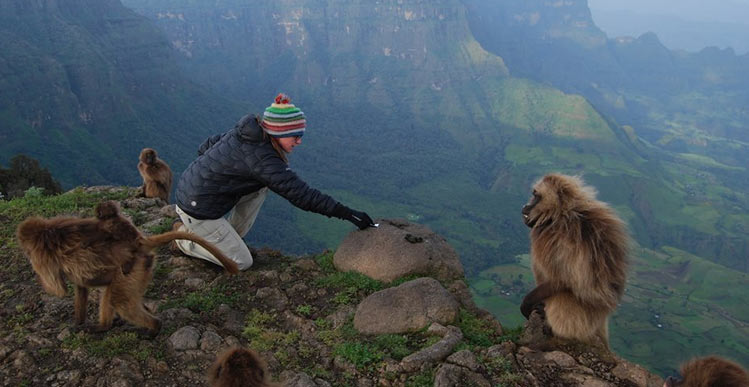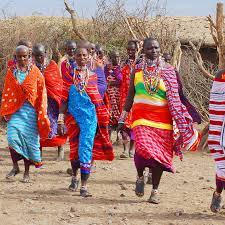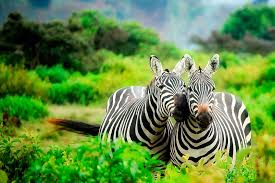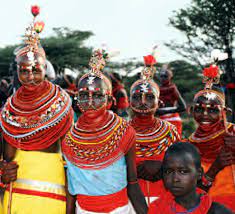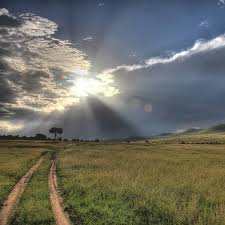Overview
landscape shaped by nature and traditional agriculture. The natural beauties of this region have always filled visitors from Ethiopia and abroad with awe. Gentle highland ridges at altitudes above 3600 meters above sea level (m asl), covered with grasses, isolated trees (Erica &bored) and the bizarre Giant Lobelia (Lobelia rhynchopetalum) are found on the high plateau that ends abruptly at 1000- to 2000-m deep escarpments. The margins of this high plateau consist of precipitous cliffs and deep, canyon-style gorges. In some places, the escarpment forms small elevations that offer splendid natal lookout points. The spectacular views from the observation points at Gidir Got and lmet Gogo in the center of the Park offer unparalleled panoramas along the high plateau and down to the lowland areas. Given the right meteorological conditions, views reaching up to a hundred kilometers over the valleys and the terraces of the Tekeze lowland basin are no exception. Geologically speaking, the entire highlands of the Simien mountains consist of dark Trapp basalt and bright, soft turf. They alternate and constitute a massive complex that is more than 3000 m thick. This complex was formed by volcanic eruptions in the Tertiary Oligocene-Miocene Age some 20-30 million years ago; ever since, it has been going through processes of uplifting and erosion. The main attraction of the Simien Moumains National Park is its biosphere: the steep cliffs and the cool climate at the altitude of the Erica tree line (3600 to 4000 m ash) have created conditions that are appropriate for the survival of an ibex species (Capra ibex wee) endemic to the Simien Mountains. Despite the severe restriction of their habitat over the last centuries, several hundred animals have survived up to the present. Apart from the Walya ibex, many other animal species are found in the Park, for example the endemic Simien fox or Ethiopian wolf (Canis .071817,51-3 simony’s), several birds of prey, the endemic Gelada baboon ( Theropithecusgelada), the Klippspringer (Oreotragus omotragus), and the bush buck (liagelphus scriptus). The rareness of these species formed the backbone of the concept for conservation of the area, which led to the establishment of the Simien Mountains National Park in 1969, and its listing as a World Heritage Site in 1918. The human population living in the area adds to the distinctiveness of this special natural environment. The traditional lifestyle of the rural population and their survival in a rather harsh climate and with scarce natural resources make for the most striking impressions a visitor will have when trekking in the Park and its surrounding rural area.
Best Time to Visit
For many people, the best time to visit Ethiopia is during the dry season, which runs from October through February. There are exceptions to this rule, however—especially if you’re interested in experiencing Ethiopia’s cultural festivals, some of which are held during the rainy season. If you’re on a budget, traveling during the low season is also a good way to save money.
The Weather in Ethiopia
Although Ethiopia’s climate varies greatly depending on the region you’re planning on visiting, the wet season generally lasts from June to September, with light rains beginning as early as March. June and July are the wettest months, particularly in the Northern Highlands. Weatherwise, therefore, the best time to travel is from October to February, when the climate is both dry and sunny. At this time of year, nighttime temperatures can drop dramatically, so it’s important to pack plenty of layers. If you’re planning on heading south to the Omo Valley, you need to be aware that there are two distinct rainy seasons in this region.
Best Time to Visit the Northern Highlands
The October to February dry season is the best time to plan a trip to the ancient rock-cut churches of Ethiopia’s stunning Northern Highlands. However, even during the wet season, rains rarely last all day. If you’re looking to save money, consider booking a trip in March or April, when the rains are light and prices for accommodation and tours are generally lower. Usually, it’s best to avoid traveling in June and July, when the rains in this region are at their most extreme.
Best Time to Trek the Simien Mountains
The Simien Mountains are a vast mountain range whose highest peak stands at 14,901 feet, making it one of the highest mountains in Africa. Trekking here is fantastic, not only because of the scenery, gorges, and streams but also because you get a chance to look for endemic wildlife like the gelada baboon and the walia ibex. The best time to trek is from September to November, when it’s dry, green, and relatively dust-free. October, in particular, can be spectacular because this is when the mountain wildflowers are in full bloom.
Best Time to Visit the Omo Valley
With more than 50 tribes living in the Omo River region of southwestern Ethiopia, it’s a fascinating destination for those interested in African culture. The remote location, which is barely accessible by four-wheel drive, means that traditional customs and beliefs are very much intact for most of these tribes. This region has two rainy seasons, with one lasting from March to June, and a shorter one in November. Access is often impossible during these times, so planning your trip for the dry season is essential.
Best Time to Visit the Danakil Depression
Danakil is one of the hottest places on earth, with daytime temperatures easily reaching 122 degrees Fahrenheit. It’s a fascinating destination where you can witness the age-old tradition of salt caravans, experience Afar culture, and marvel at a myriad of active volcanoes. If you’ve ever felt the urge to visit another planet, you’ll love the extraordinary landscapes of this region. To avoid feeling like you’re boiling alive, however, make sure to visit during the cooler months of November to March.
Best Time for Experiencing Ethiopia’s Festivals
Ethiopian festivals are certainly worth planning a trip around. Mostly religious, festivals generally last several days. Orthodox Christian festivals are the most prominent and visible in Ethiopia and are celebrated according to the Ethiopian calendar. For example, Ethiopian Christmas (known as Ganna) is celebrated on January 7, rather than December 25. Enkutatash, the Ethiopian New Year, is celebrated on September 11. If you’re keen to experience Ethiopian festivities at their most colorful, consider planning your trip around Meskel or Timket, but be prepared to book your domestic flights and hotels well in advance.
Key Festivals & Events
Timket, the Feast of Epiphany held on January 19, is Ethiopia’s biggest festival, celebrating the baptism of Jesus. The festival lasts for three days, and includes a procession of the church’s tabot, or consecrated replica of the Arc of the Covenant; and ritual re-enactments of the baptism. When the more solemn aspects of the festival are over, participants enjoy feasting, music, and dancing. The best places to enjoy the festival are Gondar, Lalibela, and Addis Ababa. It is worth joining a tour, just to make sure that you are able to reserve accommodation. It’s also good to have a guide who can tell you exactly what is going on during the processions. Later in the year, the country celebrates Meskel on September 27. Meskel is an old Christian festival that has been celebrated in Ethiopia for over 1,600 years. It commemorates the discovery of the cross upon which Jesus was crucified. Some pieces of the cross are thought to have been brought to Ethiopia. The best place to celebrate the festival is in Addis Ababa’s Meskel Square, where a colorful procession of priests, deacons, and choir singers walk around a huge pyre, bearing ceremonial crosses and wooden torches decorated with olive leaves. The torch-bearers set the pyre alight, and the next day people go to the bonfire and use the ash to make the sign of the cross on their foreheads before spending the rest of the day feasting.
Spring
Ethiopia’s spring is sometimes known as the harvest season and spans from September through November. Belg, as it’s called, also kicks off the country’s dry period, making it a great time to visit.
Events to check out:
Enkutatash, or New Year’s Day, takes place every year on September 11.
Meskel, or Finding of the True Cross, is celebrated on September 27. This festival is among the country’s largest, celebrated with a huge procession of priests, deacons, and choirs.
Summer
Kiremt is the summer season, which runs from June through August. These months are punctuated by heavy, intense rainfall at times.
Events to check out:
Islamic holidays, such as Eid al-Fitr and Eid al-Adah, usually fall during the summer months.
Fall in Ethiopia
Tseday is the name of the season that runs from March through May, and what most would consider fall. There are occasional showers, and May is usually the hottest month in Ethiopia.
Events to check out:
Adwa Victory Day is held in early March, commemorating a battle fought between the Ethiopian empire and Italy.
Ethiopia’s national day is called Derg Downfall Day and takes place on May 28.
Winter in Ethiopia
December through February constitute winter, or bega, in Ethiopia. These months are very dry and it’s not uncommon for mornings to be frosty.
Events to check out:
Ethiopian Christmas is a huge celebration which always takes place on January 7
Established in 1969 and located in the far north of the country, Simien Mountains National Park is part of the breathtaking Ethiopian Highlands. A wonderland of dramatic plateaus, valleys, sheer cliffs and towering peaks, it is sometimes referred to as Africa’s answer to the Grand Canyon and includes Ethiopia’s highest peak, Ras Dejen (14,930 feet/4,550 meters). The eastern section of the park is designated as a UNESCO World Heritage Site and described by the organization as “one of the most spectacular landscapes in the world.” In terms of geology, the Simien Mountains are similar to South Africa’s Drakensberg Mountains. Both were formed by outpourings of lava between 40 and 25 million years ago. Today, visitors flock to the national park to admire its fabulous scenery, look for rare wildlife and embark upon multi-day treks. The Simien Mountains are also one of the few places in Africa to regularly see snow. Rare Wildlife The national park is home to several incredibly rare animals, which was one of the biggest motivations for protecting it as a UNESCO World Heritage Site. These include the Ethiopian wolf (also known as the Simien fox), the Walia ibex and the gelada monkey. Ethiopian wolves are the most endangered carnivores in Africa and the rarest canids in the world, with only 400 left in the wild. The endangered Walia ibex and the gelada monkey are both exclusively found in the Ethiopian Highlands. Other exciting animals to look out for include the Anubis and hamadryas baboons, the klipspringer antelope and the golden jackal; while the national park is also ranked as an Important Bird Area.
More than 130 bird species have been recorded here including 16 endemic species. It’s especially great for spotting mountain-dwelling raptors such as the magnificent and unmistakable bearded vulture, the Verreaux’s eagle and the lanner falcon.
Getting There
The closest major city and airport is Gondar, located 90 miles (145 kilometers) to the southwest. From there, it’s a 1.5-hour drive to the park headquarters in Debark (itself an hour’s drive from the park entrance). The easiest way to get from Gondar to Debark is in a private vehicle or with a tour transfer, but the route is plied by public buses and minibuses as well. It is essential that you stop first in Debark to purchase your entry permit, as it’s not possible to do so at the park entrance. Permits costs 90 birr per adult, per day. You can also organize maps, information and official national park guides at the Debark park office. It is easy to explore the park independently (after paying a 20 birr charge per private vehicle). However, if you would rather join an organized tour, there are several operators that offer Simien Mountains trekking itineraries. Locally owned Tesfa Tours and SimienEcoTours both receive good reviews and focus on providing a sustainable experience that benefits local communities as well. Tesfa Tours specializes in privately guided and small group tours, while SimienEcoTours offers fixed date departures from Debark for groups of up to 10
Activities
The park’s extraordinary wildlife aside, the main attraction for most visitors is the scenery. There are two ways to explore — via 4WD vehicle or on foot. The park is intersected by an unpaved road which runs from the town of Debark in the west to the village of Mekane Berhan in the east. It takes you past several of the region’s traditional Amharic villages and through the incredibly beautiful Buahit Pass (13,780 feet/4,200 meters). On clear days, it’s often possible to see up to 60 miles (100 kilometers) across the canyon-filled lowlands. For a more immersive experience, don your hiking boots and backpack and hit the park’s hiking trails. Options range from easy day hikes to challenging multi-stage treks.
- Top Hiking Trails
- Buyit Ras – Chenek
- Debark – Chenek – Debark
- Sankaber – Adi Arkay
- Buyit Ras – Adi Arkay
- Weather & When to Go
- Where to Stay
Uniqueness
Massive erosion over the years on the Ethiopian plateau has created one of the most spectacular landscapes in the world, with jagged mountain peaks, deep valleys and sharp precipices dropping some 1,500 m. The park is home to some extremely rare animals such as the Gelada baboon, the Simien fox and the Walia ibex, a goat found nowhere else in the world.

